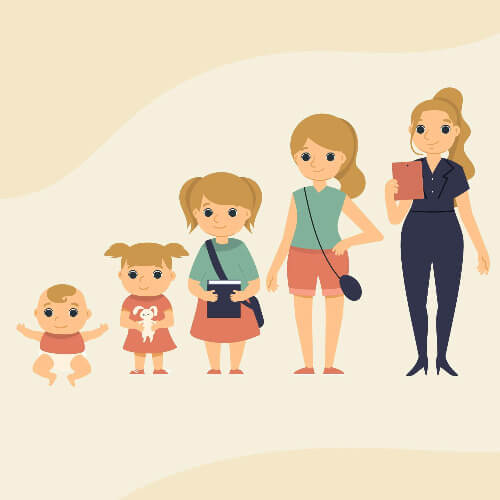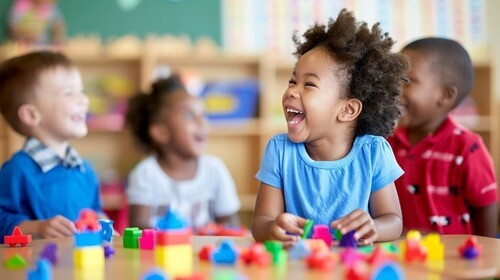Stages of Growth and Development from Infancy to 18 Years Old?
Parenting is a journey filled with countless milestones and unforgettable moments. Watching your child's stages of growth and development is nothing short of fascinating.
 The cycle of life. Stages of growth and development.
The cycle of life. Stages of growth and development.When milestones are met it's most often due to your child's environment, genetics and your support and love.
I have compiled a list of how kids develop cognitively, emotionally, socially, and physically from newborn to the beginning of adulthood.
This list contains only general guidelines. It’s quite normal for children to reach their stages of growth and development at different times.
Infancy (0-2 Years)
Physical Development
- Newborns (0-3 months): During this stage, babies gain control over their head and neck movements. They start to lift their heads during tummy time and follow objects with their eyes.
- Infants (4-6 months): Babies begin to roll over, sit with support, and reach for objects. By six months, many start to sit without support.
- Babies (7-12 months): Crawling, standing with assistance, and eventually walking are key milestones. Their pincer grasp (fore finger and thumb or middle finger and thumb) is developed at this stage, allowing them to pick up small objects.
Cognitive Development
- Early Infancy: Babies start to recognize caregivers and respond to sounds. Putting objects in their mouths is how they explore their environment.
- Later Infancy: They begin to understand object permanence – knowing that objects still exist even when they can't be seen.
Emotional Development
- Attachment: Infants form strong bonds with caregivers, this is important for their sense of security.
- Expressing Emotions: They begin to show a wider range of emotions, including joy, fear, and frustration.
Social Development
- Interaction: Babies respond to social stimuli, such as smiling when smiled at.
- Playing: They engage in simple games like peek-a-boo and begin to recognize themselves in mirrors.
 Mom is holding babies hand while they are just learning to walk. Baby is excited and proud.
Mom is holding babies hand while they are just learning to walk. Baby is excited and proud.Early Childhood (2-6 Years)
Physical Development
- Motor Skills: Children refine their motor skills. At this point they are beginning to run, jump and climb. They are developing their fine motor skills and are able to draw manipulate small objects.
- Growth: This period sees steady growth in height and weight.
Cognitive Development
- Language: Vocabulary expands rapidly. By age 3, most children can form short sentences, and by age 5, they can tell simple stories.
- Thinking Skills: They develop the ability to think symbolically, engaging in pretend play and understanding basic concepts like counting.
Emotional Development
- Self-awareness: Children become more aware of their emotions and begin to understand others' feelings.
- Independence: They strive for more independence, often showing a strong will and preferences.
Social Development
- Play: Play becomes more cooperative as your child learns to take turns with others and share their toys.
- Friendships: They start forming friendships and show interest in playing with peers.
 Children in a day care setting, sharing toys and taking turns, laughing and talking.
Children in a day care setting, sharing toys and taking turns, laughing and talking.Middle Childhood (6-12 Years)
Physical Development
- Coordination: Improved coordination and strength. They start to become better in physical activities and other sports.
- Growth Spurts: Periods of rapid growth, especially as they approach puberty.
Cognitive Development
- Academic Skills: Significant advancements in reading, writing, and mathematical skills. They understand about the more difficult ideas and it is easier for them to think logically.
- Problem-Solving: They have the ability to solve problems and and can understand cause and effect of relationships.
Emotional Development
- Self-esteem: Developing a sense of self-worth. They may face challenges like peer pressure.
- Emotional Regulation: Better at controlling and expressing emotions in appropriate ways.
Social Development
- Peer Relationships: Friendships become more stable and influential. Peer acceptance becomes important.
- Teamwork: Ability to work in groups improves. They understand and follow rules better.
 Tween at school by her locker with friends.
Tween at school by her locker with friends.Adolescence - Adulthood (12-18 Years)
Physical Development
- Puberty: Significant physical changes, including growth spurts and the development of secondary sexual characteristics.
- Mature Body: Most girls grow quicker than boys throughout their childhood and will finally stop growing by age 15 or 16.
Eg. Between all the boys and girls in my class throughout public school, I was always the tallest and I absolutely hated it. I finally stopped growing at 5’9" which was a relief.
- Boys on the other hand, are almost always shorter than girls throughout their younger years in school, up until grade 10 or 11 at which time they shoot up like a rocket.
Eg. My cousin, was an average height for his age in grade 10. I went away for a year. When I returned and saw him, I could not believe a child could grow that much in such a short time. He had grown a foot in just one year.
If I recall correctly he was about 16 by this time and continued to grow a four more inches over the next 2 years.
Cognitive Development
- Abstract Thinking: Ability to think abstractly, reason logically, and plan for the future.
- Moral Reasoning: Developing a personal code of ethics and values.
Emotional Development
- Identity Formation: Exploring and forming their own identity. This can involve questioning beliefs and values.
- Emotional Intensity: Experience strong emotions and may struggle with emotional regulation.
Social Development
- Independence: Seeking independence from parents and more reliance on peer relationships.
- Intimate Relationships: Begin to form romantic relationships and deeper friendships.
 Teenage Relationship between a boy and girl. They are in the library sitting at a table, looking at one another and smiling.
Teenage Relationship between a boy and girl. They are in the library sitting at a table, looking at one another and smiling.Is it Normal for My Child to Be Behind in Certain Stages of Growth and Development?
Absolutely. Every child is unique and develops at their own pace. It’s important to remember that the stages of growth and development only serve as general guidelines.
Some children may reach certain growth and developmental milestones earlier or later than their peers. This variation is perfectly normal.
A child’s development can be influenced by such factors as genetics, individual temperament or even the environment.
It’s always a good idea to talk to your child’s pediatrician if you have concerns about them. They can assess your child and make any appropriate referrals to support your child’s growth.
Key Takeaways
- Monitor Milestones: Keep an eye on child developmental milestones but understand that each child is unique.
- Encourage Growth: Support your child's development through engaging activities and a nurturing environment.
- Seek Advice: Don't hesitate to seek professional advice if you have concerns.
Parenting is a wonderful journey with its own set of difficulties and joys.
You can better support your child and celebrate their path through life if you understand the stages of growth and development.

















































New! Comments
Have your say about what you just read! Leave me a comment in the box below.